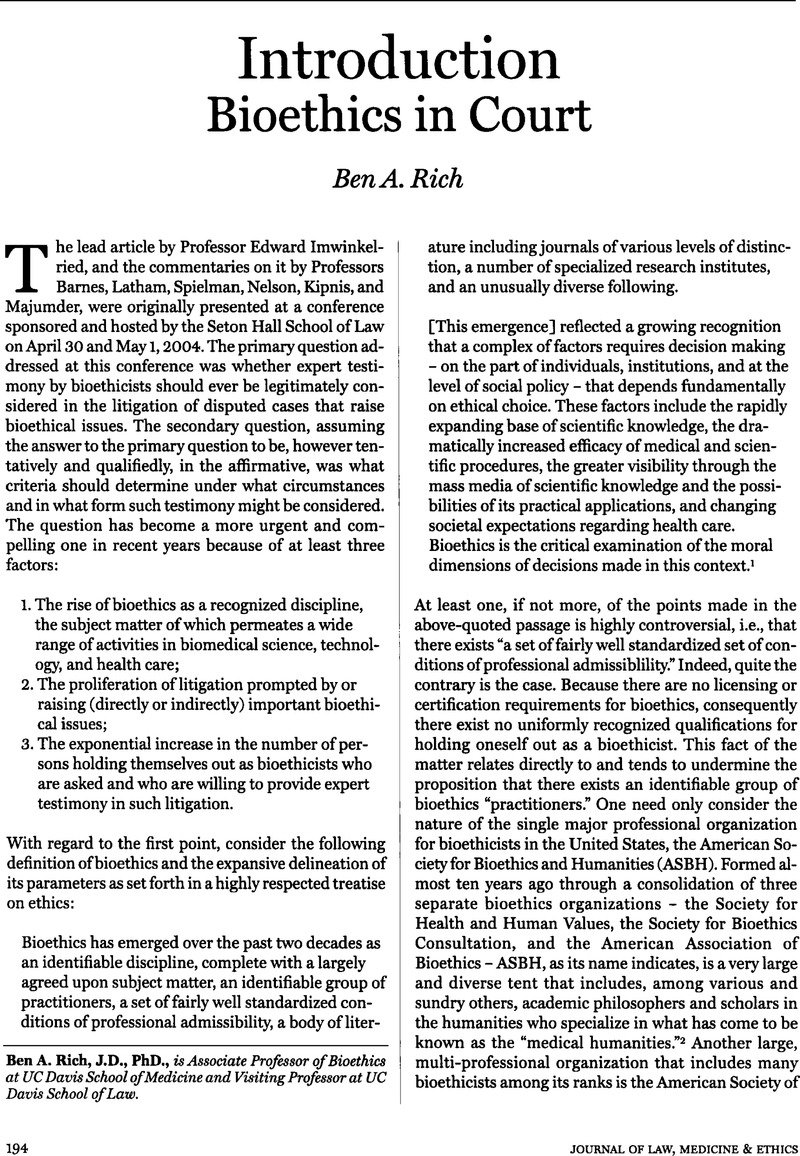No CrossRef data available.
Article contents
Introduction Bioethics in Court
Published online by Cambridge University Press: 01 January 2021
Abstract
An abstract is not available for this content so a preview has been provided. Please use the Get access link above for information on how to access this content.

- Type
- Introduction
- Information
- Copyright
- Copyright © American Society of Law, Medicine and Ethics 2005
References
Gorovitz, S., “Bioethics,” in Becker, L. C. and Becker, C. B., eds., Encyclopedia of Ethics (New York: Garland Publishing, Inc., 1992): 89–91.Google Scholar
The home page of the ASBH website states: “The ASBH is a professional society of more than 1,500 individuals, organizations, and institutions interested in bioethics and the humanities.” Membership is declared to be open to “healthcare professionals, teachers, consultants, and others who have an interest in the field of clinical and academic bioethics and the health related humanities.” The long list of affinity groups within ASBH includes such diverse interests as: Dental Ethics, Environmental Bioethics, Literature and Medicine, Race, Culture/Ethnicity, Rural Bioethics, and Visual Arts & Cultural Representations, <http://www.asbh.org> (Last visited March 18, 2005).+(Last+visited+March+18,+2005).>Google Scholar
Caplan, A., Keynote Address, Holocaust and Bioethics Conference, Minneapolis, MN (1989), cited in Annas, G. J., “The Dominance of American Law (and Market Values) Over American Bioethics,” in Grodin, M., ed., Meta Medical Ethics: The Philosophical Foundations of Bioethics (Dordrecht: Kluwer Academic Publishers, 1995): 83–96.Google Scholar
Rothman, D. J., Strangers at the Bedside: A History of How Law and Bioethics Transformed Medical Decision Making (New York: Basic Books, 1991).Google Scholar
Annas, G. J., Standard of Care: The Law of American Bioethics (New York: Oxford University Press, 1993): at 3.Google Scholar
German Military Tribunals, “Permissible Military Experiments,” Trials of War Criminals Before Nuremberg Tribunals Under Control Law Vol. 2, No. 10 (Washington, D.C.: U.S. Government Printing Office, 1947): 181–184.Google Scholar
See Salgo v. Leland Stanford Jr. Univesity Board of Trustees, et al., 317 P. 2d 170, 181 (1957).Google Scholar
American Medical Association Council on Ethical and Judicial Affairs, Code of Medical Ethics, § 8.08 (Chicago, IL: American Medical Association, 2002).Google Scholar
Annas, , supra note 5, at 86.Google Scholar
Meisel, A. and Kuczewski, M., “Legal and Ethical Myths about Informed Consent,”. Archives of Internal Medicine 156 (1996): 2521–2526.CrossRefGoogle Scholar
Capron, A. M., “Law and Bioethics,” in Reich, W. T. ed., Encyclopedia of Bioethics (New York: Macmillan, 2nd. Ed 1995): 1329–1335.Google Scholar
For two other divergent views of the influence of law upon the ethics and practice of medicine see Dworkin, R. B., LIMITS: The Role of the Law in Bioethical Decision Making (Bloomington: Indiana University Press, 1996); Rich, B. A., Strange Bedfellows: How Medical Jurisprudence has Influenced Medical Ethics and Medical Practice (New York: Kluwer Academic/Plenum Publishers, 2001).Google Scholar
Posner, R. A., The Problematics of Moral and Legal Theory (Cambridge, MA: The Belknap Press of Harvard University, 1999).Google Scholar
Dworkin, R., “Assisted Suicide: The Philosopher's Brief,” The New York Review of Books, March 27, 1997, at 41.Google Scholar
410 US. 113 (1973).Google Scholar
505 U.S. 833 (1992).Google Scholar
497 U.S. 261(1990).Google Scholar
Casey, , supra note 19 at 850.Google Scholar
Casey, , supra note 19 at 851Google Scholar
Tribe, L. H., American Constitutional Law, 2nd ed. (Mineola, NY: Foundation Press, 1988): at 1308.Google Scholar
See Shiner, R. A., “Law and Morality,” Patterson, D., ed., A Companion to the Law and Legal Theory (Oxford: Blackwell, 1999): 436–449.Google Scholar
The Principle of Double Effect originated in medieval catholic theology. It is a method of moral analysis that has as its purpose the determination of whether an act that has both good and bad consequences can be ultimately considered morally acceptable or unacceptable. If all 4 of the following criteria are met, then according to the principle the act can be deemed to be morally acceptable. Those criteria are: 1) the act itself must be morally good or at least neutral; 2) the bad result may be foreseeable but not intended; 3) the good result must not be directly caused by the bad result; and 4) the good result must be proportionate to the bad result. In contradistinction to criterion number 2 of the Principle of Double Effect, which seeks to make a distinction with moral implications between foreseeing and intending, the law has traditionally taken the position that every person may be presumed to intend the natural and probable consequences of his or her actions. Thus, one who engages in an act which has a foreseeable consequence may be presumed to act with the intent of bringing about that consequence.Google Scholar
Dworkin, supra note 9, at 41.Google Scholar
Annas, G. J. Glantz, L. H. Mariner, W. K., Brief for Bioethics Professors, November 12, 1996. The primary argument of the amicus brief was that the essential holding of Roe v. Wade should be upheld. Indeed, the brief deliberately avoided any direct confrontation with the morality of abortion, instead offering support for a woman's legal right to chose to end her pregnancy prior to viability.Google Scholar




